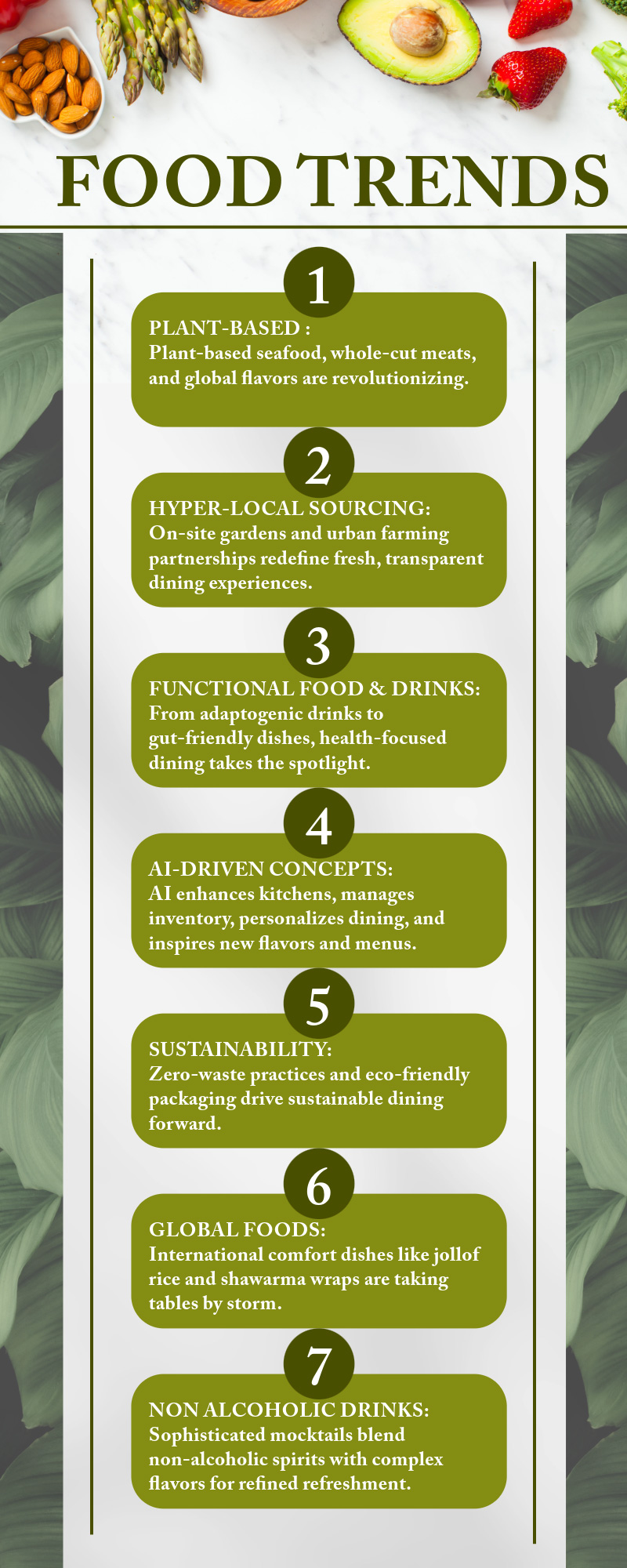As we enter 2025, the culinary world continues to evolve, driven by innovation, sustainability, and shifting consumer preferences. Staying ahead of these trends can help restaurant owners and foodservice operators attract customers and adapt to the ever-changing market. Here are the top food trends expected to dominate 2025:
Plant-Based Evolution
The plant-based movement is no longer limited to burgers and milk alternatives. In 2025, expect to see:

- Seafood alternatives: Plant-based shrimp, crab, and tuna from seaweed, legumes, and fungi.
- Whole-cut meats: Innovations in texture and flavor now offer plant-based steaks and chicken breasts that closely mimic the real thing.
- Cultural flavors: More plant-based dishes inspired by global cuisines, from Ethiopian injera to Thai green curry.
Hyper-Local Sourcing
Consumers are increasingly prioritizing locally sourced ingredients. Restaurants are taking this further by:
- Growing their own produce in on-site gardens or vertical farms.
- Partnering with hyper-local suppliers, such as urban farmers and community-supported agriculture programs.
- Highlighting the origins of ingredients on menus to build trust and transparency.
Functional Foods and Beverages
The rise of health-conscious dining is driving demand for foods and drinks that offer functional benefits, such as:
- Adaptogenic beverages to reduce stress and improve focus.
- Gut-health-focused dishes featuring fermented ingredients like kimchi and miso.
- Protein-packed snacks and meals incorporating ingredients like quinoa, chickpeas, and insects.
- Wellness drinks: Cold-pressed juices, herbal teas, and infused waters designed to promote hydration, energy, and relaxation.
AI-Driven Culinary Innovations
Artificial intelligence is making its mark on the food industry, enabling:
- Personalized menus: AI analyzes customer preferences to suggest tailored dishes.
- Efficiency in the kitchen: Smart appliances and AI systems streamline food prep and minimize waste.
- Help with inventory management and reservations: Automated systems track stock levels, predict ordering needs, and optimize seating arrangements.
- Dining room experiences: Interactive displays and AI-generated "guests," such as virtual celebrities, create immersive dining experiences.
- Flavor experimentation: AI helps chefs discover new flavor combinations and improve recipes.
Sustainability Takes Center Stage
Eco-conscious dining is more important than ever, with restaurants embracing:
- Zero-waste practices, including creative uses for food scraps.
- Sustainable packaging options, such as edible or compostable containers.
- Alternative proteins from sustainable sources, like algae or lab-grown meats.
Global Comfort Foods
As travel restrictions ease and cultural exchange grows, consumers crave comfort foods with an international twist. Popular dishes include:
- Japanese soufflé pancakes.
- West African jollof rice.
- Middle Eastern shawarma wraps with creative fillings.
Robotics in Foodservice
The integration of robotics is becoming more common, with robots assisting in:
- Automated cooking and food assembly.
- Contactless delivery and order fulfillment.
- Improving consistency and reducing labor costs in high-demand settings.
Experiential Dining
Restaurants are focusing on creating memorable experiences for diners through:
- Immersive themes include dining in a rainforest or underwater setting.
- Interactive elements, like build-your-own dishes or tableside cooking.
- Incorporating technology, such as augmented reality menus or holographic projections.
Crossover Flavors
Fusion cuisine continues to thrive, with unexpected pairings and mashups gaining traction. Think:
- Korean-Mexican tacos.
- Indian-Italian pizzas with masala toppings.
- Mediterranean-Asian sushi burritos.
Alcohol-Free Cocktails
With the rise of sober curiosity, alcohol-free cocktails are gaining sophistication, featuring:
- Distilled non-alcoholic spirits.
- Herbaceous and botanical infusions.
- Artisanal syrups and bitters for complex flavor profiles.
Conclusion
The food trends of 2025 reflect a blend of technological advancements, environmental consciousness, and a desire for unique culinary experiences. By embracing these trends, restaurant owners can cater to evolving consumer demands and position themselves as industry leaders.


